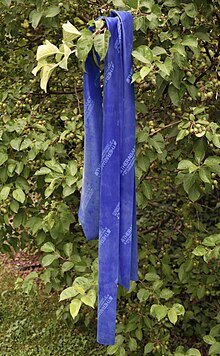Latex strap
A latex band (or exercise band) is an elastic band that is used in physiotherapy for general physical fitness or for strength training .
In the field of physical therapy, the bands are often used as therapy tape , Physio tape , Theraband or power strip called. Most latex straps are very thin, about one to three meters long, and not closed.
General
Many manufacturers offer latex tapes in different colors, which symbolize different strengths. The meaning of the individual colors varies from manufacturer to manufacturer. The tensile strength can be varied for each band if the bands are gripped for a shorter time; it doubles when the tape is grasped twice.
Latex straps are available as a closed ring version like the Deuser strap and as a simple strap, the more common variant. Many manufacturers offer latex tapes off the roll so that the length can be determined by the customer. The bands are often supplied with clips that can be used to create a closed band from the simple band. This further expands the range of accessible muscle groups .
One advantage of the latex straps is their size. They can be stored in a space-saving manner and are also very easy to transport, so that extensive training can also be carried out on the go, which has earned them the nickname “smallest fitness studio in the world”.
safety
Before using a latex tape, it should always be checked for damage to prevent it from tearing under tension. Otherwise, there is a considerable risk of injury, especially with stronger ligaments. Talc keeps the tape supple and dry and thus ensures a longer service life. Ligaments are usually damaged by fingernails and jewelry, so it is advisable to remove rings and the like before doing the exercises. Also, latex straps should be wrapped around the hand rather than grasping it directly. This gives a secure hold and relieves the hand.
Areas of application
Many different muscle groups can be trained with latex bands in numerous exercises; For example, there are exercises for the back and for arm, leg, buttock and shoulder muscles. In turn, specific muscle groups can be targeted by the individual areas. Latex straps can be used in a very targeted manner and also train coordination .
Today, like many others , the German national soccer team is training with elastic bands again, because the muscle groups that are important for soccer can be targeted in a targeted manner.
to form
Deuser band
The Deuser band is a ring-shaped, relatively thick band made of rubber for training the muscles . The tape is mainly used in the training of various types of sport for stretching and endurance training, as well as for rehabilitation gymnastics .
The band got its name from its patentee, the physiotherapist Erich Deuser . Deuser was one of the first to use elastic bands for athletes. From 1951 to 1982 he was in charge of the German national soccer team and initially used bicycle tubes for strength training with soccer players , until in 1967 he developed a rubber strap for more targeted use with different tensile forces .
The official inventor and patent holder of the Deuserband is the manufacturer Heinrich Deike.
The Deuserband is available in different weight classes. There are five different resistance levels, with light (light) to dark (difficult) available in stores. You can do different exercises with it, limited the same as with weights or dumbbells. The Deuserband is also available as a "light" version. The handles supplied are practical here, so that the Deuser-Band Light can be gripped like an expander.
Theraband
The Theraband from the company of the same name is a latex band which, due to its popularity and popularity, is also used as a generic term for latex bands. "Thera-Band" is protected as a trademark.
See also
literature
- Urs Geiger, Caius Schmid: Muscle training with the Thera-Band: The exercise program for fitness and therapy . 4th, revised edition. BLV Verlagsgesellschaft, Munich 2004, ISBN 978-3-405-16742-4 .
- Mirelle Dorit Herpel: Training properly with the Thera-Band . 1st edition. BLV Verlagsgesellschaft, Munich 2006, ISBN 978-3-8354-0067-2 .
- Hans-Dieter Kempf: Back training with the Thera-Band: Fit and healthy with small devices . 9th edition. Rowohlt, 2000, ISBN 978-3-499-61001-1 .
- Hans-Dieter Kempf, Astrid Lowis, Horst Lichte: Fit and beautiful with the Thera-Band: training book for women . 5th edition. Rowohlt, 1999, ISBN 978-3-499-19479-5 .
- Hans-Dieter Kempf, Andreas Strack: Strength training with the Thera-Band: The best exercises . 6th edition. Rowohlt, Reinbek 1999, ISBN 978-3-499-19484-9 .
- Hans-Dieter Kempf, Frank Schmelcher, Christian Ziegler: Training book Thera-Band: The program for fitness and health . 15th edition. Rowohlt, Reinbek 1996, ISBN 978-3-499-61004-2 .
- Horst Meise, Gesine Ratajczyk: Thera-Band and body trainer tubing . 1st edition. Meyer & Meyer, Aachen 2007, ISBN 978-3-89899-285-5 .
- Caius Schmid, Urs Geiger: Rehatrain: Exercises with the Thera-Band . 2nd, revised edition. Urban & Fischer Verlag, 2000, ISBN 978-3-437-45331-1 .
- Thorsten Tschirner: 8 minutes are enough: Fit with the Thera-Band . 5th edition. Gräfe & Unzer, 2006, ISBN 978-3-7742-8869-0 .
- Nina Winkler: Body shaping with the Theraband . 1st edition. Südwest-Verlag, 2008, ISBN 978-3-517-08403-9 .
Web links
- Academie de Danse: Flexibility training with the Deuserband
- Württembergischer Tennis-Bund: Strength training with the Theraband Part 1 upper body ( Memento from December 14, 2007 in the Internet Archive ), Part 2 legs ( Memento from December 13, 2007 in the Internet Archive ) (saved version from the Internet Archive )
- active-online.ch: strength program with the Theraband (PDF; 214 kB)
- ACSM: Selecting and Effectively Using Rubber Band Resistance Exercise (engl.)
Individual evidence
- ↑ depatisnet.de: Patent No. 1949617 of the sports device
- ↑ DPMAregister. In: register.dpma.de. Retrieved August 13, 2019 .
